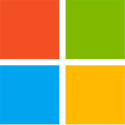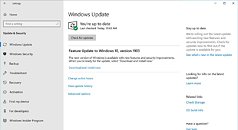Friday, April 5th 2019

Microsoft Reconsiders: No More Forced Updates in Windows 10
One of the big no-nos for some users looking to upgrade do Windows 10 was the fact that Microsoft enforced constant, 6-month update cycles independent of whether users wanted them or not. This move was done to streamline the update process and keep all users at parity when it comes to important security and feature updates that Microsoft considered relevant. However, it seems Microsoft is now abandoning this practice, which means that users that like to know exactly what is being changed in their systems - and at a time of their convenience - now have one less reason to not upgrade.
Not only will Windows no longer push updates inadvertently, now home users will also have the ability to not only pause updates, but also remove them. There's a caveat, though - you won't be able to postpone feature updates forever. As it stands, Microsoft has an 18 month "end of life" period for major Windows 10 versions, which means that after your 18 months of postponing updates are up (and all of the kinks have been ironed out), you PC will still update to the latest version. There are some other details, which I will transcribe from the Microsoft blog post for your perusal.
Sources:
Microsoft Blog, Reddit
Not only will Windows no longer push updates inadvertently, now home users will also have the ability to not only pause updates, but also remove them. There's a caveat, though - you won't be able to postpone feature updates forever. As it stands, Microsoft has an 18 month "end of life" period for major Windows 10 versions, which means that after your 18 months of postponing updates are up (and all of the kinks have been ironed out), you PC will still update to the latest version. There are some other details, which I will transcribe from the Microsoft blog post for your perusal.
Download and install now option provides users a separate control to initiate the installation of a feature update on eligible devices with no known key blocking compatibility issues. Users can still "Check for updates" to get monthly quality and security updates. Windows will automatically initiate a new feature update if the version of Windows 10 is nearing end of support. We may notify you when a feature update is available and ready for your machine. All Windows 10 devices with a supported version will continue to automatically receive the monthly updates. This new "download and install" option will also be available for our most popular versions of Windows 10, versions 1803 and 1809, by late May.
Additional improvements to put users more in control of updates that are being introduced with the May 2019 Update include:
- Extended ability to pause updates for both feature and monthly updates. This extension ability is for all editions of Windows 10, including Home. Based on user feedback we know that any update can come at an inconvenient time, such as when a PC is needed for a big presentation. So, we're making it possible for all users to pause both feature and monthly updates for up to 35 days (seven days at a time, up to five times). Once the 35-day pause period is reached, users will need to update their device before pausing again.
- Intelligent active hours to avoid disruptive update restarts. The active hours feature, introduced in the Windows 10 Anniversary Update, relies on a manually configured time range to avoid automatically installing updates and rebooting. Many users leave the active hours setting at its 8 a.m. - 5 p.m. default. To further enhance active hours, users will now have the option to let Windows Update intelligently adjust active hours based on their device-specific usage patterns.
- Improved update orchestration to improve system responsiveness. This feature will improve system performance by intelligently coordinating Windows updates and Microsoft Store updates, so they occur when users are away from their devices to minimize disruptions.

149 Comments on Microsoft Reconsiders: No More Forced Updates in Windows 10
Screw them.
Win 7 FTW.
Can't stand the gui of 10 and how menus have been changed etc.
A step in the right direction, but not quite there yet. Here's to hoping we get there before Januray...
I only upgraded to ensure that compatibility for gaming was optimal.
Their profit idea lies in the Store and in cloud. If you don't use them, this is the cheapest Windows OS ever. And even the most feature rich at that too.
Since for a good chunk of power-users, the bare prospect of running/using an operating-system which bricks itself every couple of weeks to months, the forlornness of the world's biggest OS-developer being literally un·able to maintaining a given minimum on stability and the sheer hopelessness in fighting a losing battle with no end in sight of regaining the ultimate control of the OS (or its respective updates … cough) as the user, due to forced (stability- and/or function-) bricking updates, that was the nail in the coffin for them on Windows 10 – and only to a much lesser extent the issues on privacy.
Well, if …
Though, if wishes were horses, beggars would ride.
Smartcom
I don't understand what this is about at all.
Instead of forced updates every six months it will be once every 18 instead? That's all?
The Falls Creator update that forced it's way to my Plex server and then broke itself, that was a very pleasant experience! Nothing like watching my RAID1 setup take a shit because Windows broke so bad it couldn't be repaired.
After that I figured Win 10 would constantly break any RAID configuration so I opted to just simply using my second HDD to do a full backup with Acronis every couple of weeks.
It took me forever to locate tge control panel and get the normal icons that have been with us since 95/98 on the desktop too
Whatever, click on the start button - I don't see it showing up in all the crap that's littered across the start menu.
Fine. In the search bar I type in "my computer" and nothing comes up.....seriously, now. WTF?
Screw it - I just type "c:\" to bring up the window for the c drive.
Later found out it's called "This PC" and no longer "My Computer"
Tell me. What the hell is the point in renaming something after all these years?
I have a process that I perform whenever I install Windows 10 to disable all the crap and get it to a usable state. Now I have it on all of my systems and haven't had too many problems.